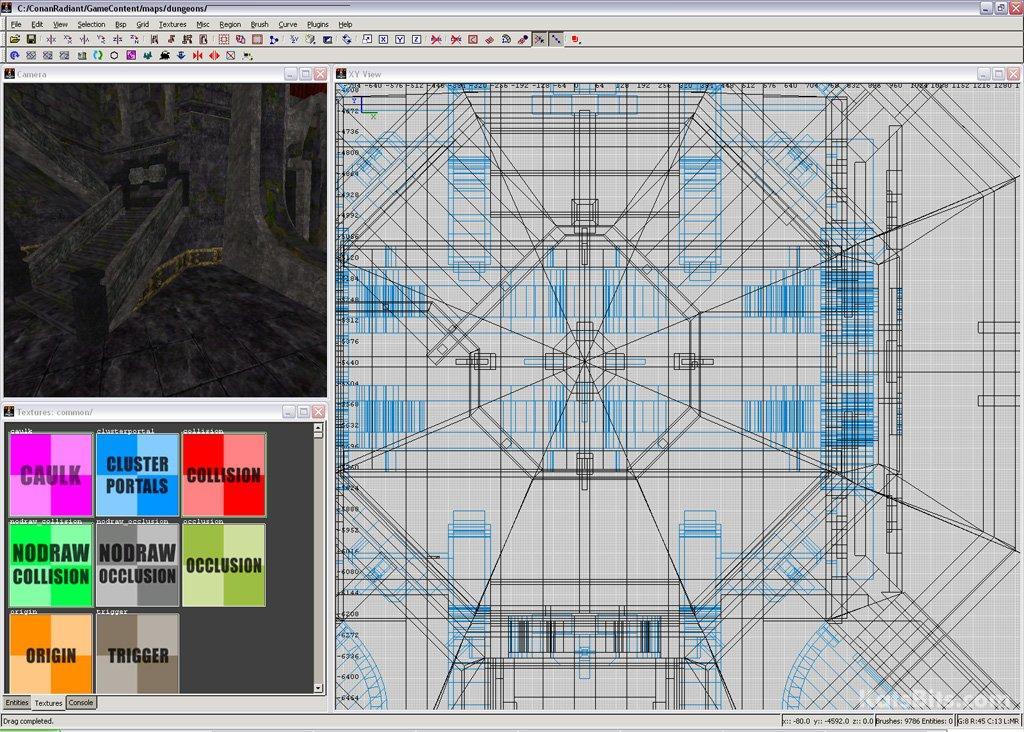Conan: Hyborian Adventures, the making of #2
Conan dungeon design, content creation and conversation
kat: With Conan having an PvP (MP) aspect how do you fit ‘game play’ into the overall design of the levels? In other words, what are you looking at or for when you design them?
Mr Lycon: It was difficult to design the PvP maps for Conan because when we started the game-play code wasn’t there, so what we tried to do was design ‘key’ areas. I have never been a fan of "tunnel-room-tunnel-room" maps, which it’s very easy to do if you have little experience, so what I tried to do was design the maps to use some z (height) action.
In Conan that was very difficult due to the nature of the combat and how it works, it’s not like Quake or traditional FPS games, so we tried to take into account the range on characters like spell-casters and archers, trying to design those key areas in a way that they had some sort of advantage but at the same time weren’t exploitable (camping). With most of the layout design we tried to do multiple paths where one path was quick but dangerous, and another was safe but then again would take longer, so, if you saw someone run down there with the flag you could take the dangerous route to cut them off.
We also had to stick to important design limitations resulting from using the "real" architecture the art director wanted; it had to feel authentic to fit the Conan universe so we couldn’t just make a ledge here and an angle there, even if it would be better game-play wise, as it would look totally off, in unreal or quake you can over exaggerate like that.
kat: Looking at the work-in-progress images, it’s noticeable that ‘lightmaps’ are used. How is that done in Conan?
Mr Lycon: Lightmaps are rendered using 3DS Max, we UV map the dungeon (which is a pain in the butt) then copy that UV layer and do a pack UV’s, then we render a lightmap first, and then we render a ambient occlusion map and combine those with multiply blending; it takes a while, but at the same time you have full control over what’s going on to get the best visual look, it’s more like an ambient occlusion render (background light) than directional lighting (lights that have a source).
kat: Doesn’t that mean you’re dealing with lots of unique assets? How are the meshes actually textured?
Mr Lycon: Not really, we try to keep the ‘assets’ down to a minimum since the actual dungeon mesh is so detailed. Speaking for my self I at least did the texturing after I had build these dungeons, I did the UV mapping while I was building since I knew roughly what textures I was going to use, but the final texturing was done when the dungeon was build and tested.
kat: So you’d be texturing relative to using a ’tiled’ texture or are you using ‘unique’ texture maps per object (relatively speaking).
Mr Lycon: All textures we use, well more or less anyway, are ’tiled’ textures that repeat. But we get round the problem of ‘unique’ lightmaps by using two different UV layers; UV channel "1" for ‘normal’ textures, and UV channel "2" for the ‘lightmap’ texture.
kat: Using lightmaps means the lighting isn’t fully dynamic doesn’t it? So ‘stylistically’, how do you find working with that sort of ‘combination’ lighting?
Mr Lycon: I would call it semi-dynamic since we have the lightmap, but it works. The great thing about it is that you get a much better level of detail doing it with a combination; you would never get the same light details using full dynamic lighting and shadowing with current technology and hardware. But of course, it has some limitations as well, like we can’t have pitch black rooms suddenly fully lit so we have to design around that problem. The last thing then done is to add in particles and adjust the ambient feel of a level with fog, ‘godrays’ etc. etc.






